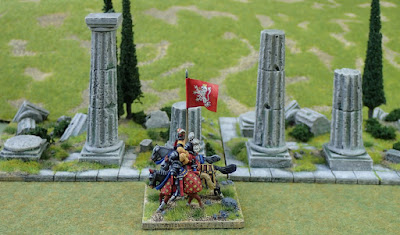My last unit with hand painted elaborate shields. I have the figures for two more bases so I will have the option of a 4 or 6 base unit but first I'm concentrating on getting all the Cavalry units with 4 bases and all the infantry with 6. I will bother about the extras and alternatives once I have a usable army.
Again this unit is mix of Minifigs and Asgard figures originally bought in the 80s with a few more recent extras to make the numbers up. By mixing up the two Asgard and one Minifigs cavalryman figures (plus command figures, with a bit of head swapping and modification) and alternating Asgard and Minifigs horses, I wanted to break up the 1980s monotony of mono-posed figures. Of course the down side of that is having to accept figures with very different kit: Minifigs with spangenhelm helmets, scale armour and no cloak with Asgard figures with an Attic-style eastern or spangnhelm helmet, mail and cloaks. The Asgard officer and cavalryman with spangenhelm helmet had rather large shield bosses so I filed those off and replaced them with Milliput to match the size of the others. As usual, I drilled out the figures hands and replaced the cast spears and javelins (and in the case of the office, his mace) with brass wire spears so these were all the same.
I've rationalised the remaining lack of uniformity with a story. This unit has a mix of veterans from the Danube frontier (hence the spangenhelm) and more recent recruits from the wars against Persia and now serving back in the North. Those soft Southerners are feeling the cold a bit and wearing their cloaks whilst the veterans are already too warm, so have stowed their cloaks behind them (from packs of Skytrex WW2 vehicle stowage) and are wishing they could take off their armour and head down to the quayside where a short-sleeved tunic is more than enough insulation against the refreshing Northern breeze. I'm choosing to ignore that scale armour is supposedly more characteristic of Eastern troops.
Another thing that has bothered me about those old figures is that, whilst all the army lists gave them javelins and spears, they are cast with one or the other. For my Illyrian unit, I got round this by having them hold spears in their right hand and a few javelins in their left, behind their shields but that seemed unsatisfactory so, for this unit, I made javelin quivers with two or three javelins from 0.5 mm brass rod (my spears are an over-scale 0.8mm) glued to a paper back with aluminium foil flaps and Milliput to represent the "bag". I held then in a pin vice to apply the Milliput, as in the photo, then again after the Milliput had cured to clean it all up. The rather short conical points are meant to represent the counterweight / non-sharp end of the javelin as shown in Osprey's 'Late Roman Cavalryman AD 236-565'.
I chose the shield pattern partly based on colour and partly because I felt I should have some shields with animals (albeit mythical ones). I only realised later that this is one of the handful of Late Roman shield patterns offered in the excellent Little Big Men range and so my hand painting efforts to get something unique are, yet again, going to be upstaged by every Late Roman army with Legio Heroica or Khurasan figures having a much superior representation of the same unit.
I made a new vexillum from brass rod with the cross-piece soldered and aluminium foil to replace the thick cast one on a bendy and fragile pole. Its bearer also got a new head from a spare infantry figure to replace the classical looking helmet of the original figure. I wish now that I had done a few more head swaps for ridged helmets to tie their appearance in better with the infantry.
I have a unit of cataphracts in the painting tray now then another general and figures for the camp.



































